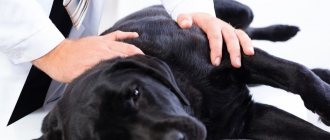Finding a lost pet is a painful process for every owner. If the animal did not have a GPS tracker to track its location, the search is carried out blindly. Dog lovers have developed a simple algorithm of actions that works in 80% of cases. Read on to find out how to find a dog if it has run away.
How to find a dog if it has run away
Use a scented item
This is the best tip for finding lost dogs that hunters have used for centuries to find their own lost dogs. Combine this tip with the rest of the tips listed below.
Dogs have an excellent sense of smell: not only can they smell a scent from afar, but their brains are designed in such a way that smell provides the dog with various information. Not only that, but research has shown that dogs have a favorite scent—their owner—which means they will prioritize your scent over everything else.
To use this to your advantage, choose a scent that may be part of your (dog owner's) clothing that you've been wearing for a while - the longer the better. Take this scent to the area where the dog was last seen or where you think it ran away from. You can also bring your dog's crate, toys, blanket, etc.
Leave the scent in this area and come back later that day or the next day. Return to this place every 6-12 hours. Ideally, your dog will end up waiting for you in this area, at some point leaning on your clothes. This is how many owners have found missing dogs.
Note : You can also leave a bowl of water along with a scented item, but do not leave any food so as not to attract other animals. Alternatively, you can select multiple locations and do the same in multiple locations and then keep checking them. Finally, consider leaving a note (especially if you leave a dog crate there) for anyone who encounters these things.
© shutterstock
Thoroughbred and mongrel - who has better chances?
A dog wearing a properly fitted harness.
Photo from the site myzooroom.ru Anastasia Shukaeva says that there are no exact statistics indicating which dog is faster. “But thoroughbreds are found, I think, more often. They are more noticeable and, I repeat, there are help teams for breeds, and people are increasingly turning to them immediately (both those who have found them and those who have lost them).
It’s easier to explain that a pug is lost than to say that a spotted mongrel with one erect ear and the other recumbent has disappeared.”
If your lost dog is purebred, you must inform the breeder . Because there is a possibility that your dog ended up with knowledgeable people, and they, having selected a purebred animal, will first check the brand, run it through the database, and call the breeder with a message about the find, explains Oksana Dubinina. “And if the dog is from a shelter or “curated,” be sure to inform the dog’s curator,” Oksana recommends. – People involved in adopting animals have a lot of resources to notify the whole world about the loss of a dog. This means there are great prospects for finding it.”
A dog is called “curated”. which was taken home from the shelter, and for which at first the activists of the shelter and its owners look after it. Recently, among animal lovers it is considered the correct and approved action not to buy a puppy from a breeder, but to save a dog from a shelter, so a “curated” dog is not an isolated phenomenon, but part of a new everyday life.
Oksana Dubinina cites as an example one of the many cases of her own experience of searching for a dog. “This happened to my handler dog. In the morning call: “Hello! Have you ever lost your shepherd?” I looked at my mongrels and said: “No, my houses.” “And she has your phone number written on her collar.” - “Please describe the dog and tell me where you found it?” - “Moskvoretskaya embankment...well, so thin, about 15 kilograms, red-haired with a dark muzzle.” - “Does he respond to Amalia?” – “Amalia, Amalia….Ohhh! yes, it responds!” And then I shout: “Oh! Girls, please hold it! We’ll pick it up now!” - “Yes, yes, she will be here, in our law office!” Meanwhile, I already had a message on my phone and unanswered calls from the owner Amalia. It turned out that the dog had wriggled out of the collar on which hung a tag with the owner’s phone number, but there was still a cord with my phone number. Half an hour later Amalia was home! The main thing is to approach your friendship with animals responsibly. The dog will not tell you his address and phone number, but you yourself can always prevent the loss or bring the dog back to you closer.”
Whistling and shouting
While some escaped dogs may be roaming around the area, take into account the fact that your puppy could be trapped somewhere. Maybe the dog's collar got caught on something, or the dog accidentally got stuck behind a fence. Your dog may be somewhere nearby, but just can't get home.
Whistling and shouting the dog's name while walking around the neighborhood seems obvious, but for some reason many owners forget to try it. So give it a chance and see if your dog answers your call with his bark. After playing a little Marco Polo, you might just find a missing dog waiting for you to rescue.
Hope percentage
Having an address card or tag will help the pet return home.
Photo from the site classpic.ru “Search success is guaranteed in 80% of cases, even with not very active searches,” says Anastasia Shukaeva. “If the dog has a tag, then everything is much simpler and faster. And, by the way, a passport with a chip can then help prove that this is your animal,” the expert notes.
“I myself found all my lost ones, and with the help of personal searches. She went and called. For example, there was a case when an adopted dog that lived in our shelter ran away from its new owners. I arrived, and she responded to my voice, we found her in five minutes,” Anastasia cites her experience as an example. “But what helped me most was the online newsletter: a lot of people immediately called, reported the whereabouts of the dog, or sometimes held it until we arrived.”
A certain percentage of losses remain with the new owners. “Among my friends there are also those who kept the animal they found,” says Anastasia. – Most often this happens due to the fact that it was not possible to find the owners. But in the end, they themselves fell in love with the dog and realized that it was fate. These are, of course, happy stories. It’s much sadder when a lost dog disappears on the street and becomes homeless.”
Check your GPS navigator.
The obvious action to take when searching for a missing dog—if you've taken the precaution of equipping your pet with a GPS dog collar or simple GPS tag locator—is to check and locate your dog. Even some simple fitness/activity trackers may have a GPS locator that you didn't know about, so check to see if you had that option.
These nifty safety accessories often cost a monthly subscription on top of the initial price of the device, but can tell you exactly where your dog has run off to, but also track their activity by monitoring their heart rate. However, not every pet owner has these useful products, in which case additional measures must be taken.
Keep your phone handy
Regardless of the circumstances, the first thing many people will do when they find a lost dog is check that pet's collar for tags and check the tags to see how to contact the owner. Many dog ID tags allow owners to provide more than one phone number, which can increase your chances of contacting the good citizen who found your pet.
When you put an ID tag on your dog, you can also include your cell phone, landline, or your number and that of a family member. When your dog is missing, make sure your phone is always ringing so you will receive a phone call as soon as there are any new developments.
Statistics and predictions for success
When purebred pets go missing, the chances of finding them are always higher. They are easier to distinguish from strays than ordinary mongrels. Special groups dedicated to helping specific breeds also contribute.
Another advantage of purebred origin is the presence of a mark. It is very easy to find the breeder, so it is better to notify this person in advance about the disappearance of your pet.
Owners of four-legged friends from the shelter should not despair either. At first, they are monitored by a curator, so you can always turn to him for help and support.
The chances of success increase if you have a brand, a chip and a token with the owner’s phone number. Eight out of ten missing people can be returned home.
Do some research
Revisit the area where your dog escaped and ran away, and search nearby. A little detective work of your own can go a long way in finding your missing dog. Ask your neighbors if they heard or saw anything. Nearby loud construction or fireworks can cause a frightened animal to leave the area and hide in a quieter place.
Did your dog accidentally leave something behind? Any information you discover will determine the next steps you need to take. For example, perhaps when your puppy burrowed and squeezed under the fence in the backyard, his collar broke. In this case, you will at least know that no one will be able to contact you.
You can also conclude that anyone who happens to see your dog without a collar will think it is a stray and may call animal control, which will lead you to the next step you should take: calling local shelters.
Four-legged traveler
Microchipping a dog in a veterinary clinic.
Photo from vetlab.ru If you are traveling with a dog, you need to use special equipment. “Like I do. I use a collar plus a harness. In this case, I take or two short leashes - one is fastened to the collar, the other to the harness, or re-clasp, this is when one end of the leash clings to the collar, the other end to the harness,” advises Oksana Dubinina. This will help in a situation where an animal, frightened, breaks out and can run away in an unfamiliar place, on a highway, at a train station; gets lost in the crowd. In any case, a harness is more reliable than a collar; a dog can wriggle out of a collar. If the dog is still lost in a place unfamiliar to it, the ideal option is to stay and wait for it. “There is a high probability that the dog will return to the place where it last saw its owner,” explains Oksana Dubinina. At the same time, you need to methodically examine the entire area around and loudly call the dog by name. The animal could be hiding in fear, so you need to look through all the nooks and crannies. “No one knows your dog better than you; try to model its possible behavior based on its character and habits,” our expert recommends. Police, security, salespeople, janitors, loaders - everyone who comes across your path should know your phone number (ideally write 50 copies of “business cards”, this can be done as quickly as possible, but it is better to take such notes with contacts with you). Open a photo of a dog on your phone and show it to everyone.
Don’t be afraid to seem “hysterical”; people will understand that the loss of a dog is a grief for you, and they will be more likely to take your requests seriously and join the search. Remember that with each passing hour the likelihood of finding your dog will decrease!” – advises Oksana Dubinina.
Be sure to put a tag on your dog with a phone number (address book). On one side write the dog's name in large letters and on the other your phone number. It is better if it is a separate cord rather than a collar. Collars get lost and can be easily removed if the dog is trusting and approaches people on its own. If the collar is lost, a cord with an address tag remains.
Our experts recommend microchipping your dog. Nowadays there are many knowledgeable people who, having discovered a lost dog (especially a purebred one), immediately take it to the veterinary clinic to scan the chip. “It will help you quickly find your contacts, even with a general skepticism towards information bases in our country,” notes Oksana Dubinina.
Sterilization and castration of an animal also largely eliminates escapes motivated by the “call of nature.” “According to statistics, castrated dogs live on average several years longer than non-castrated ones, are less likely to get lost, and are less likely to die under wheels. A sterile dog (even a fashionable breed) is not a desirable object for theft,” explains Oksana Dubinina.
Even if we admit that there are shady nurseries and unscrupulous breeders who can “order” or accept a stolen purebred dog, then in any case, by sterilizing your dog, you obviously make it “not interesting” for this kind of business. And yes – always keep your dog on a leash in unfamiliar places, even if you are proud of its obedience and are sure that “my dog will definitely not run away.”
Ask and notify local shelters
A crucial step in finding a missing dog is to contact organizations that do this every day. Most people who see a dog running away will call animal control, and unless the dog has some form of identification (microchip or tags), they will likely be sent to the local animal shelter.
© shutterstock
Call all animal shelters closest to where your dog is lost and explain the situation. They will probably ask if the dog has ID; otherwise, they will ask for multiple descriptions of your animal.
Email the shelter a photo of the dog and some helpful characteristics, such as your dog's age, overall size and weight, coat color and length, and any unique traits such as odd fur markings or scars.
Social networks and public support
Photo from the site brothers-smaller.ru
In parallel with announcements in yards, information about a missing dog or cat must be disseminated on the Internet. You need to use social networks and help groups , as well as personally contact animal lovers. “The wider the audience reach, the better the result. Miracles, but this method works great! – notes Anastasia Shukaeva. “According to my observations, the most effective activities are posting advertisements “on the ground” and reposting them online.”
An irreplaceable resource of our time is social networks and specialized websites. For example:
- https://propalasobaka.org/
- https://www.hochusobaku.ru/mboard/poteryalas/
- https://www.lostdog.ru/lost/dog
- https://claws.ru/cgi-bin/base.pl?base=1
Remember that “ask marketing” is very important on social networks. Ask for help correctly! Be sure to include in your messages a large, high-quality photo of your dog and complete information about the loss. Be sure to ask your friends to repost and spread your request.
Also, notes Anastasia Shukaeva, there is a possibility that the animal was caught and then sent to a shelter. Call the shelters and ask first about the dates of capture - if it agrees, then ask in more detail.
Shelter volunteers are willing to help in the search , notes Anastasia. a Rottweiler assistance team, a “tax team” and other similar network groups) could help him
Tell others
No matter where you live, neighbors are a powerful resource that can potentially help you find your lost companion and even give you more helpful tips and information on how to find your missing dog.
In rural areas where your neighbors are not easily accessible in the neighborhood, post a missing dog flyer at high traffic businesses such as a popular local diner, post office or grocery store. Many of these commercial buildings have a public board that you can use for free, but if not, you can politely ask the staff if you can use their window space.
What to do if you find someone's dog
Finding yourself on the other side is no less exciting. First of all, people are afraid of the possibility of infecting their own pets, so only a few are involved in foster care. Despite this, there are many more ways to help a “lost” person.
Identification
If the animal is in no hurry to approach you, be careful. The stress experienced can turn into aggression. If you have seen a flyer about the loss or recently spoke with the injured owner, contact him by phone without letting the dog out of your sight.
Calm animals can be taken to a veterinary clinic or to volunteers. If there is a stamp or chip, they will be quickly returned to their owners.
If all possible identifiers (including the address number) are missing, you will have to follow the same algorithm as the owner. Online and offline advertisements can help here.
Count your dog's favorite places
There are many reasons why our faithful dogs may run away, but sometimes it doesn't require much guesswork. Dogs have favorite places. Maybe it's a dog park you frequent together on the weekends, or maybe it's a house a few blocks away that has a doggie buddy they're dying to visit.
Either way, one of your pet's favorite places may be where he has escaped to. If you have no other ways to find your missing dog, the first thing you can do is find it, starting with its favorite places and doing more Sherlock Holmes-like detective work.
How to prevent your dog from going missing
- Microchipping . Consider using a GPS tracker and always have your dog microchipped and use ID tags.
- Provide security . If your dog frequently leaves the house or yard, revisit the area where he escapes from. Regular maintenance, such as replacing rotting wood, can better keep your dog safe. If your dog is good at jumping fences, there are things you can do to prevent it.
- Invest in toys . If your dog is often lost, he may be very bored and lonely while you're away. It may seem simple, but purchasing some time-consuming chew toys, especially interactive dog toys or other mechanics designed specifically for dogs, can reduce their urge to escape.
- Make your dog famous . If you live in a small town with a friendly neighborhood where others also have dogs, you can all work the same way Neighborhood Watch works. Create a dog business card with a photo of your beloved pet and your cell or work phone number. Share this with your neighbors (and encourage them to share theirs with you).
Dog owner identification
Over many decades, a multi-stage system for checking owners has been developed.
After claiming your pet, you should request the following information:
- Photo. Real owners should have a large number of photographs of the dog. Only high-quality, non-blurry photographs depicting the pet at different ages are taken into account.
- Nickname. Each dog responds only to its own name.
- Distinctive features. A detailed description of the pet's appearance will help in identifying the owner.
- Inspection of the apartment. If an animal lived in the room, traces of its presence will be visible everywhere.
When meeting with owners, you need to observe the dog's reaction. If she willingly makes contact, you can be sure that the search for the owners will be successful.
A dog should be shown to prospective owners only after a thorough telephone interview










